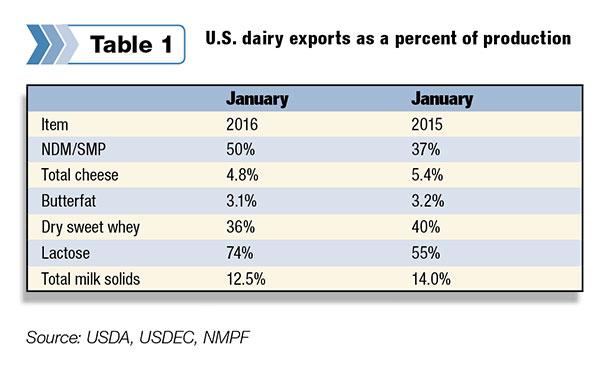Milk powders remain the brightest spot in an otherwise cloudy U.S. export picture, as global retail dairy product prices continued to weaken.
Powered by powders, U.S. exporters shipped 138,089 tons of dairy products in January 2016, 10 percent more than the prior year. However, those gains are relative to a weak performance in January 2015, according to Alan Levitt, with the U.S. Dairy Export Council.
The January 2016 exports were valued at $362.3 million, down 10 percent from last year, and the lowest figure since January 2011.
Overseas sales of nonfat dry milk/skim milk powder (NDM/SMP) totaled 42,896 tons in January 2016, up 23 percent from the prior year and the most ever for any January on record. Leading markets were the Philippines, Indonesia and Vietnam. Sales to Mexico also were above a year ago.

On a total milk solids basis, U.S. exports were equivalent to 12.5 percent of U.S. milk production in January, down from 14.0 percent in 2015 (Table 1). Imports were equivalent to 4.4 percent of production, the highest since February 2009.
Read the full USDEC report.
CWT assists with 3.9 million pounds of cheese, butter exports
Cooperatives Working Together (CWT) accepted six requests for export assistance to sell 1.581 million pounds of Cheddar and Monterey Jack cheese and 2.315 million pounds of butter (82 percent milkfat) to customers in Asia, North Africa, the Middle East and Central America.
Bids were accepted from Dairy Farmers of America, Land O’Lakes, Maryland-Virginia Milk Producers Association and Northwest Dairy Association (Darigold). The product has been contracted for delivery in the period from March through September 2016.
So far this year, CWT has assisted member cooperatives to sell 9.815 million pounds of cheese, 7.716 million pounds of butter and 6.848 million pounds of whole milk powder to 13 countries. The sales are the equivalent of 314.194 million pounds of milk on a milkfat basis.
February global dairy price index weakens
The global index of food prices was steady in February 2016, but dairy prices declined further, according to the latest United Nations’ Food and Agriculture Organization (FAO) Food Price Index.
The FAO Food Price Index is a measure of the monthly change in international prices of a basket of five food commodities – cereal, vegetable oil, dairy, meat and sugar. While the FAO Food Price Index was steady in February 2016, it’s still nearly 15% less than one year ago.
The February 2016 FAO Dairy Price Index declined 2.1 percent from January. The dairy index includes global average prices for butter, cheese, and skim milk and whole milk powders. Lackluster import demand, especially by China, and ample available supplies for export resulted in dairy product prices falling across the board. With anticipation of large supplies for short-term needs, some importers limited purchases for stocks replenishment.
Looking at other commodities:
• The February 2016 FAO Meat Price Index was up marginally, with beef moving higher.
• Cereals were down marginally, and remain nearly 14 percent less than February 2015.
• Sugar’s index was down 6.2 percent from the previous month.
• Vegetable oils were up as much as 8 percent from January, reaching the highest level June 2015.
See the full UN FAO Food Price Index report here. PD

-
Dave Natzke
- Progressive Dairyman Editor
- Progressive Dairyman
- Email Dave Natzke





